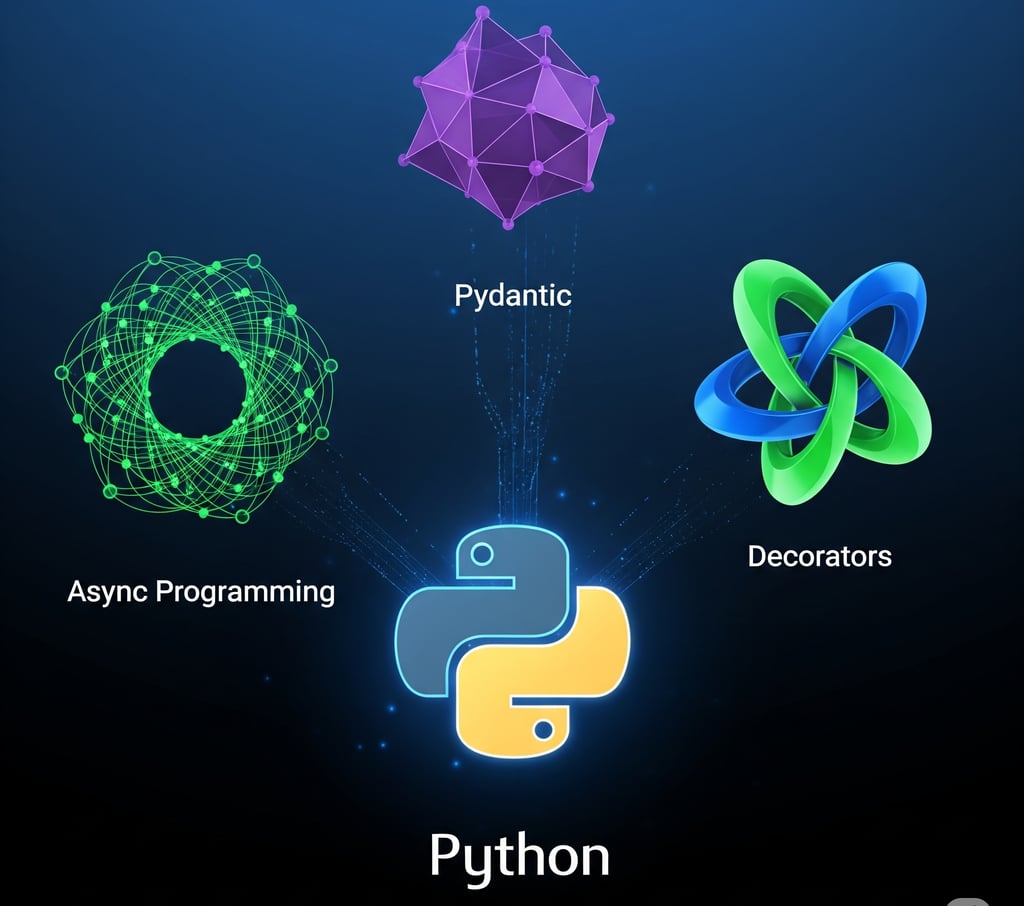3 Python Concepts That Actually Matter Before Building AI Agents
Before building AI-powered agents, mastering certain Python skills is essential. This blog covers why deeper concepts like async programming, data validation, and clean code patterns matter, using simple explanations and small examples. Learn how these skills make your AI systems faster, more reliable, and ready for real-world use.
AGENTIC AI
Rakesh Arya
8/8/20255 min read


Why Foundational Python Skills Still Matter in AI Systems
When people get excited about AI, they often think they can skip straight to fancy frameworks. The reality? Every smart AI system you’ve seen still relies on plain Python under the hood.
Think about it like driving a high-tech electric car—you still need to understand basic driving before you can enjoy the autopilot features.
Let’s take a real example. Suppose you’re building an AI agent that:
Fetches customer data from an API
Validates it
Feeds it into an LLM to create a report
If you don’t understand Python basics like:
How to call an API and wait for the response without blocking (async programming)
How to make sure the data you received actually matches what you expected (data validation)
How to add retry logic without rewriting code everywhere (decorators)
…then your AI agent might look like it works until something goes wrong in production. And trust me, things will go wrong.
Real-world case:
A student in my last batch built an AI-powered lead qualification bot. It worked fine on small tests, but when multiple users started hitting it at once, the responses slowed to a crawl. The culprit? They were making API calls one-by-one instead of using asyncio to run them in parallel. One small Python skill—learned later—cut their processing time from 8 seconds to under 2 seconds.
If you master these deeper Python skills before you start building agents, you’re not just “coding AI”—you’re building AI systems that can survive real-world use.
1. Async Programming for Faster AI/API Calls
When you build AI-powered apps or automations, your code often has to wait — maybe it’s calling an API, fetching data from a database, or reading a file from the network.
Normally, Python will sit and wait until each task finishes before moving to the next.
With async programming, you can start several tasks at the same time and let them run while you keep working.
Think of it like putting three dishes in the oven together, instead of baking them one after the other. The cooking still takes time, but you don’t stand around waiting for each one separately.
Here’s a simple example:
Synchronous Execution
import time
def task(name, seconds):
print(f"Starting {name}...")
time.sleep(seconds)
print(f"{name} completed.")
start = time.time()
task("Weather", 2)
task("News", 2)
task("Price", 2)
end = time.time()
print(f"Total time (synchronous): {end - start:.2f} seconds")
Output: Total time (synchronous): 6.00 seconds
Asynchronous Execution Using asyncio
import asyncio
async def async_task(name, seconds):
print(f"Starting {name}...")
await asyncio.sleep(seconds)
print(f"{name} completed.")
async def main():
start = asyncio.get_event_loop().time()
await asyncio.gather(
async_task("Weather", 2),
async_task("News", 2),
async_task("Price", 2)
)
end = asyncio.get_event_loop().time()
print(f"Total time (async): {end - start:.2f} seconds")
# Run main function
await main()
Output: Total time (async): 2.00 seconds
That’s the whole point — async doesn’t make each task faster, it lets them run together so the total time drops.
In AI workflows, this matters a lot. Imagine your agent fetching:
Customer details from CRM
Pricing from an API
Stock availability from a database
With normal code, your user might wait several seconds. With async, they could get results in a fraction of the time — and in today’s world, speed often means the difference between “great experience” and “frustrating wait.”
Learn more about this topic: https://docs.python.org/3/library/asyncio.html
2.Pydantic for Data Validation in AI Workflows
When your AI system works with data from different sources — APIs, databases, user input — you can’t assume the data will always be clean and correct.
If you skip checking, bad data can silently break your app or produce nonsense results.
Pydantic is a Python library that makes data validation simple and automatic. Instead of manually writing if statements to check every field, you define a model that describes what the data should look like.
When new data comes in, Pydantic will:
Automatically check types (string, number, list, etc.)
Convert compatible values where possible
Raise clear errors if something’s wrong
Think of it like giving your AI agent a checklist before it starts a task. If something’s missing or in the wrong format, the agent gets stopped before it can mess things up.
A Simple Example
Let’s say your agent expects a product’s name (string), price (float), and in_stock (boolean).
Here’s how Pydantic can enforce that:
from pydantic import BaseModel, ValidationError
class Product(BaseModel):
name: str
price: float
in_stock: bool
try:
item = Product(name="Laptop", price="1200.50", in_stock="True")
print(item)
except ValidationError as e:
print(e)
In this example, even though the price was given as a string "1200.50", Pydantic converts it into a float automatically. The same happens with "True" — it becomes a proper boolean value. But if we had missed a required field or given something completely invalid, Pydantic would have raised an error with a clear message, making it easy to fix.
In AI workflows, this is incredibly useful. Imagine your agent gets tool output from one service and immediately sends it to another without checking. If the first service changes its format even slightly, your whole pipeline might start failing silently. With Pydantic, you catch that problem at the very moment it happens, saving hours of debugging and keeping your AI system predictable and trustworthy.
Learn more about this topic: https://docs.pydantic.dev/latest/
3. Decorators for Adding Cross-Cutting Functionality Without Messy Code
When you’re building Python programs — especially ones that have multiple steps like an AI workflow — you often find yourself repeating the same extra actions in different functions.
Maybe you want to measure how long each step takes, maybe you want to log the inputs and outputs, or maybe you want to handle errors in a consistent way.
You could copy and paste that extra code into every function, but there are two problems with that:
Your code becomes messy and harder to read.
If you need to change that extra logic later, you’ll have to hunt it down in multiple places.
This is where decorators come in. A decorator is like a “wrapper” you put around a function. It lets you add extra behavior before or after the function runs, without touching the function’s original code.
Think of it like putting your phone in a protective case — you’ve added a new feature (protection) without changing the phone itself. And if you ever want a new case, you just swap it without messing with the phone’s insides.
Here’s a very simple example. Let’s say we want to know how long a function takes to run:
import time
def timer(func):
def wrapper():
start = time.time()
func()
end = time.time()
print(f"Time taken: {end - start:.2f} seconds")
return wrapper
@timer
def fetch_data():
time.sleep(1) # Pretend this is a slow API call
print("Data fetched")
fetch_data()
Output
Data fetched
Time taken: 1.00 seconds
What happened here is that @timer “wrapped” the fetch_data function so that it measured the time automatically.
We didn’t have to put the timing code inside fetch_data, and we can now reuse @timer on any other function we want to measure.
In AI workflows, this is powerful because you might want to add logging, error handling, or timing to many different steps — data fetching, model calls, post-processing — and decorators let you do that cleanly, without cluttering your core logic.
Learn more about this topic: https://realpython.com/primer-on-python-decorators/
Building reliable AI agents isn’t just about knowing the latest tools — it’s about having solid Python skills that make those tools work well in real-world conditions. Concepts like async programming, data validation with Pydantic, and decorators for clean, reusable code turn simple scripts into robust, maintainable systems. Mastering these before diving into agents means you’ll spend less time fixing unexpected issues and more time creating solutions that actually work.
